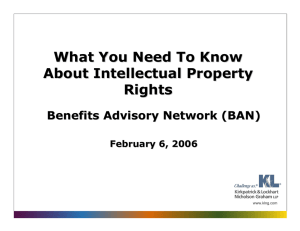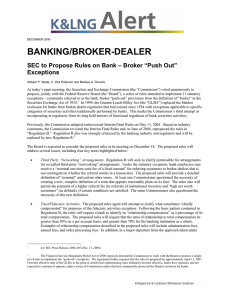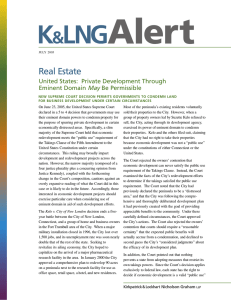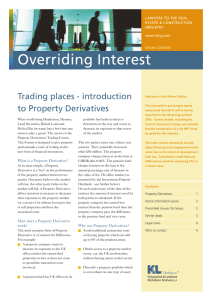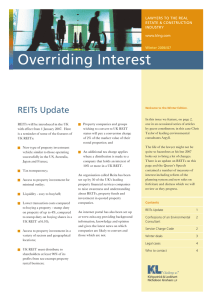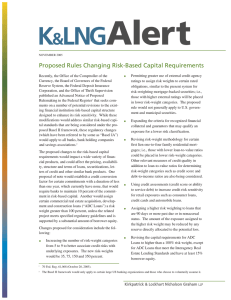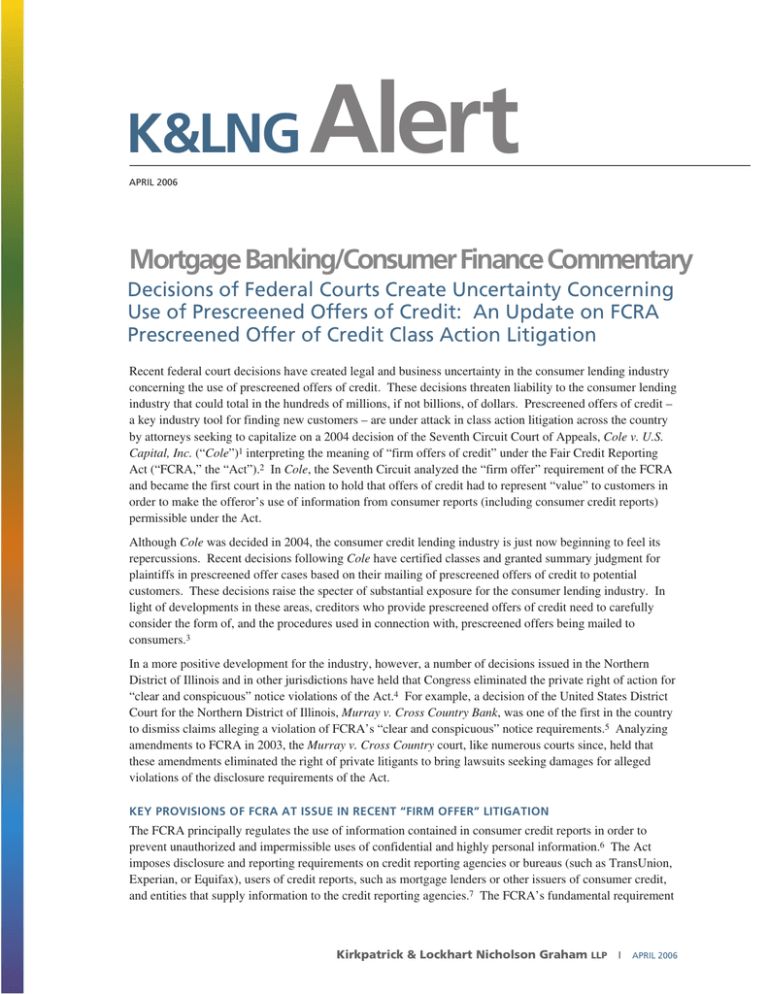
K&LNG
Alert
APRIL 2006
Mortgage Banking/Consumer Finance Commentary
Decisions of Federal Courts Create Uncertainty Concerning
Use of Prescreened Offers of Credit: An Update on FCRA
Prescreened Offer of Credit Class Action Litigation
Recent federal court decisions have created legal and business uncertainty in the consumer lending industry
concerning the use of prescreened offers of credit. These decisions threaten liability to the consumer lending
industry that could total in the hundreds of millions, if not billions, of dollars. Prescreened offers of credit –
a key industry tool for finding new customers – are under attack in class action litigation across the country
by attorneys seeking to capitalize on a 2004 decision of the Seventh Circuit Court of Appeals, Cole v. U.S.
Capital, Inc. (“Cole”)1 interpreting the meaning of “firm offers of credit” under the Fair Credit Reporting
Act (“FCRA,” the “Act”).2 In Cole, the Seventh Circuit analyzed the “firm offer” requirement of the FCRA
and became the first court in the nation to hold that offers of credit had to represent “value” to customers in
order to make the offeror’s use of information from consumer reports (including consumer credit reports)
permissible under the Act.
Although Cole was decided in 2004, the consumer credit lending industry is just now beginning to feel its
repercussions. Recent decisions following Cole have certified classes and granted summary judgment for
plaintiffs in prescreened offer cases based on their mailing of prescreened offers of credit to potential
customers. These decisions raise the specter of substantial exposure for the consumer lending industry. In
light of developments in these areas, creditors who provide prescreened offers of credit need to carefully
consider the form of, and the procedures used in connection with, prescreened offers being mailed to
consumers.3
In a more positive development for the industry, however, a number of decisions issued in the Northern
District of Illinois and in other jurisdictions have held that Congress eliminated the private right of action for
“clear and conspicuous” notice violations of the Act.4 For example, a decision of the United States District
Court for the Northern District of Illinois, Murray v. Cross Country Bank, was one of the first in the country
to dismiss claims alleging a violation of FCRA’s “clear and conspicuous” notice requirements.5 Analyzing
amendments to FCRA in 2003, the Murray v. Cross Country court, like numerous courts since, held that
these amendments eliminated the right of private litigants to bring lawsuits seeking damages for alleged
violations of the disclosure requirements of the Act.
KEY PROVISIONS OF FCRA AT ISSUE IN RECENT “FIRM OFFER” LITIGATION
The FCRA principally regulates the use of information contained in consumer credit reports in order to
prevent unauthorized and impermissible uses of confidential and highly personal information.6 The Act
imposes disclosure and reporting requirements on credit reporting agencies or bureaus (such as TransUnion,
Experian, or Equifax), users of credit reports, such as mortgage lenders or other issuers of consumer credit,
and entities that supply information to the credit reporting agencies.7 The FCRA’s fundamental requirement
Kirkpatrick & Lockhart Nicholson Graham LLP |
APRIL 2006
is that a consumer report cannot be disseminated unless it satisfies one or more of the permissible purposes
delineated under the Act.8
Not surprisingly, the Act permits the use of information from consumer credit reports in situations where the
consumer herself initiates a credit transaction or authorizes access to her credit report. The Act also permits
the use of consumer credit information in cases where the consumer does not initiate a transaction. One such
permissible purpose is obtaining or using consumer credit information to prescreen a prospective borrower
for a “firm offer” of credit or insurance, which the statute defines as “any offer of credit or insurance that
will be honored if the consumer is determined, based on information in a consumer report on the consumer,
to meet the specific criteria used to select the consumer for the offer.”9
The Act further provides that these specific criteria properly include: (1) creditworthiness as determined
according to pre-established criteria; (2) verification of the consumer’s continuing qualification under those
criteria; and (3) the furnishing of any required collateral that was identified in the offer.10 A key factor in
evaluating whether an offer of credit is “firm,” and therefore permissible, is whether the criteria for
approving the extension of credit, including these creditworthiness criteria, are established prior to the offer
being made.11 Moreover, the allowance for ongoing verification and collateral as conditions of the offer
indicates that the Act does not require that the extension of credit be absolutely guaranteed in order to pass
muster under FCRA.12
SEVENTH CIRCUIT DECISION IN COLE V. U.S. CAPITAL
APPLIES CONCEPT OF “VALUE” TO FIRM OFFER ANALYSIS
The Seventh Circuit’s opinion in Cole v. U.S. Capital puts a novel gloss on the statutory definition of “firm
offer,” holding that FCRA permits the unsolicited use of consumer reports only in cases where "value" is
being offered, as may be determined by a contextual inquiry into any number of unspecified factors.13 Cole
explained that an offer of nominal “value” to the consumer, which could arise from a combination of factors
such as a low dollar amount of the offered credit, ambiguous or contradictory terms, or complex approval
procedures, may not actually qualify as a "firm offer” under the FCRA, even if the stated amount is, in fact,
guaranteed.
The facts in Cole form an essential backdrop for understanding the court’s approach. Specifically, among
the factors considered by the Cole court in reaching its conclusion were that the stated dollar amount of the
credit offer ($300) was very low and, moreover, was conditioned upon unspecified and contradictory
terms.14 For example, the Cole offer stated that the interest rate could range anywhere from 3% to 25%,
made contradictory statements about whether the $300 credit was or was not guaranteed, and did not specify
either the repayment term or how the interest would be calculated. There was also a question as to whether
the offeror could, at its sole discretion, withdraw the offer entirely. Thus, the Cole court held that "these
missing terms render it impossible for a court to determine from the pleadings whether the offer has value"
therefore making the action not suitable for dismissal.15
The Cole court’s interpretation of the meaning of “firm offers” within FCRA’s “statutory scheme” was
buttressed by the arguments put forward by the Federal Trade Commission (FTC) in an amicus brief to the
court. In its brief, the FTC asserted that offers of credit must be evaluated according to a number of factors:
[W]hat type of credit was offered? What would be the terms of the credit? Did the creditor have a
business plan in place that fully complied with the requirements [of FCRA], including establishing in
advance the criteria for the credit? Did any consumers apply for, or actually get, this credit? …
[W]as the offer so unintelligible – were the terms so inherently confusing, contradictory or buried in
fine print – that no one applied? … Was the credit so trivial, or were there so many conditions, that it
was not meaningful?17
The Cole court applied the FTC’s multi-factor, highly contextual analysis to the offer before it, explaining
that, under FCRA, a court “must consider the entire offer and the effect of all the material conditions that
comprise the credit product in question,” holding that the challenged offer did not meet the FCRA “firm
offer” standard.18 The court, however, did not define which criteria must be included in the offer or how
they may be expressed to establish that the offer is “firm.”
2
Kirkpatrick & Lockhart Nicholson Graham
LLP
|
APRIL 2006
It should be noted that Cole was decided on a set of highly particular and, admittedly, unfavorable facts. In
addition to the extremely wide range of the interest rate and convoluted and contradictory terms, Cole
concerned an offer of a relatively small amount of credit that could be used only to purchase a new car. Cole
did not address the typical factual situation relevant in the mortgage and consumer lending industry, that is,
where the credit offered is the product being sold.
COLE DECISION CREATES WAVE OF FCRA “FIRM OFFER” LITIGATION
At the time Cole was decided, it was not clear what application, if any, the decision would have to the
mortgage lending industry and consumer credit providers. The initial guidance from district courts, however,
has not been encouraging.
As a preliminary matter, the Cole decision has given rise to a flood of class action suits alleging violation of
the firm offer of credit requirements of FCRA, many of them in Illinois and other states within the jurisdiction
of the Seventh Circuit. For example, as of a recent count, at least one hundred fifty-one “firm offer” class
actions are now pending across the country, ninety-two of which are in Illinois alone. Not surprisingly
following Cole, the particular targets of these suits are prescreened, preapproved or prequalified offers of
credit, based on information derived from consumer reports, which, plaintiffs allege, are nothing more than
solicitations for business, making the offeror’s use of the consumer report information improper under the
FCRA.
Beyond the sheer volume of the firm offer litigation, however, and still more troubling for the industry, a
spate of recent decisions by federal courts suggest that courts are evaluating firm offers of credit by means of
a very literal reading of Cole, without sufficient attention to the context of the offer and the provisions of the
Act itself. For example, in Murray v. GMAC Mortgage Corp., d/b/a Ditech.com (“Murray”), the Seventh
Circuit stated that courts reviewing challenged offers of credit could consider only the “four corners” of the
offer to determine whether the challenged offer had “value,” as articulated in Cole.19 In other words, Murray
seems to say that courts may view only the initial written communication in determining whether a firm offer
is being made, without considering any additional factors, such as the context or other conditions, which
underlay the offer.
Murray, however, does not explain how this “four corners” rule can be reconciled with the text of the Act
which (1) defines a “firm offer” as any offer that “will be honored” by the lender if the consumer meets
additional lending criteria established prior to the offer, albeit not expressed in the offer and (2) does not
require each essential term of the offer to be set forth in the initial written communication to the consumer.
Murray, further, appears to contradict Cole, in which the court held that the “value” of a firm offer must be
construed according to the entire offer and its context, and to ignore the contextual multi-factor analysis
advocated by the FTC, which analysis was cited with approval in Cole.20
Shortly following the Murray decision, a decision from the United States District Court for the Northern
District of Illinois granted plaintiff’s motion for summary judgment on a FCRA firm offer class claim in
Kudlicki v. Farragut Financial Corp. (“Kudlicki”).21 The decision is principally based on the fact that the
challenged offer stated that the “rates and terms were subject to change at any time,” reasoning that this
qualification of the offer rendered it essentially valueless, following Cole.22
Perhaps more troubling, however, was the Kudlicki court’s conclusion that the defendant’s violation of the
Act was “willful,” which requires a showing that a defendant “knowingly and intentionally violate[d] the
Act.”23 FCRA distinguishes negligent or inadvertent non-compliance with its provisions from “willful”
violations of the Act for the assessment of damages. Specifically, the Act provides for statutory damages of
$100-1000 per violation for “willful” violations of the Act and permits punitive damages as well.24 By
contrast, the Act provides that a defendant whose non-compliance was merely negligent will be liable only for
“actual damages sustained by the consumer as a result of the failure.”25 This distinction is significant because
FCRA does not have a cap for statutory damages in a class action, unlike other federal statutes regulating
consumer lending such as the Truth-in-Lending Act or the Fair Debt Collection Practices Act which cap
statutory damages in a class action at a maximum of $500,000 or one percent of the creditor’s net worth,
whichever is less. Further, negligence claims for actual damages do not lend themselves to class treatment.
3
Kirkpatrick & Lockhart Nicholson Graham
LLP
|
APRIL 2006
Kudlicki found a willful violation even though the undisputed facts showed that (i) the defendant employed a
compliance officer “to review its mailers for compliance with the FCRA before they are sent out”; (ii) the
mailers were reviewed and approved by the consumer reporting agency that provided the consumer reports
to the defendant; and (iii) the mailers were reviewed by state regulators.26 Kudlicki discounted each of these
facts and rejected defendant’s argument that it maintained reasonable procedures to assure compliance with
FCRA, agreeing with plaintiff’s contention that “because defendant’s non compliance with the FCRA is so
evident on the face of defendant’s mailer, the Court must conclude that a true compliance process could not
have existed.”27 The court stated that “the most cursory glance at defendant’s mailer [demonstrated] that no
firm offer of credit was being offered.”28 Kudlicki raises the question whether the initial written
communication to the consumer must contain detailed and complete terms of the offer, including the interest
rate and repayment term, not only to be a “firm offer” under the Act, but also to avoid being deemed a per se
willful violation of FCRA.29
Another recent decision from the Northern District of Illinois suggests, however, that Kudlicki will not be the
final statement of the courts in the Seventh Circuit as to the connection between firm offer violations and
willfulness. In Murray v. Finance America (“Finance America”), the court held, on cross motions for
summary judgment, that a prescreened offer of credit sent by a mortgage lender was not a firm offer of credit
because it lacked “important concrete terms of the home loans and confers little or no value to the
consumer.…”30 Nevertheless, the court rejected plaintiff’s contention that the court could decide that the
defendant’s firm offer violation was willful as a matter of law. Tacitly rejecting Kudlicki, Finance America
explained that “the Court is not the trier of fact and cannot make the inferential leap that because the letters
did not contain firm offers of credit, Finance America did not apply its compliance procedures or that its
procedures were inadequate” such that the violation was willful.31
Just as Finance America and Kudlicki reached opposite conclusions as to the interplay between firm offer
violations and willfulness, federal district courts outside the Seventh Circuit have reached decisions
concerning firm offers of credit that suggest that the landscape for the mortgage lending industry may not be
uniformly bleak. For example, in Putkowski v. Irwin Home Equity Corporation (“Putkowski”), the United
States District Court for the Northern District of California recently dismissed a putative firm offer class
action lawsuit, expressly declining to follow the Seventh Circuit's analysis in Cole.32 The Putkowski court
specifically rejected plaintiffs' argument, relying on Cole, that particular terms of the offer need to be stated
in a firm offer of credit, stating that the text of FCRA does not require lenders to state the interest rate nor
does it require "that [an offer] must be of sufficient value when judged by a later arbiter, as suggested by the
Seventh Circuit in Cole."33 Furthermore, the Putkowski court disagreed with plaintiffs’ contention that it
should construe the meaning of a "firm offer of credit" in accordance with the principles of contract law.34
Instead, the Putkowski court explained, proper explication of the term “firm offer of credit” is found in the
Act itself, which expressly defines and permits a "firm offer" to be conditioned upon a number of criteria that
are not stated in the offer, so long as those criteria were established prior to the selection of the consumer to
receive the offer.35
THE SEVENTH CIRCUIT DIRECTS CERTIFICATION OF A FCRA CLASS
IN MURRAY V. GMAC MORTGAGE CORP.
A threshold question in these cases, as in all class actions, is whether a plaintiff class can be certified in “firm
offer” cases. The Seventh Circuit in Murray v. GMAC Mortgage Corp. directed the certification of a
plaintiff’s class in a prescreened offer action.36
In Murray v. GMAC Mortgage Corp., the Seventh Circuit reversed the district court’s refusal to certify a
plaintiff class consisting of Illinois residents who had received an offer of credit from GMAC Mortgage’s
Ditech mortgage subsidiary. The trial court below had refused to certify the putative class on a number of
grounds, including the failure of the plaintiff to seek compensatory damages, the ruinous damages that could
result from a verdict against the defendant, and the unfitness of the named plaintiff to represent the class.
The Seventh Circuit in Murray reversed the lower court on each point, finding (a) that a plaintiff seeking
statutory damages need not also demand compensatory damages under FCRA, (b) that the named plaintiff
4
Kirkpatrick & Lockhart Nicholson Graham
LLP
|
APRIL 2006
was an appropriate class representative, (c) that class certification is an inappropriate technique for
controlling excessive damages, and (d) that it was not appropriate to consider the ruinous effect of potential
damages in deciding whether a class should be certified. The court further determined that it need not
engage in a consumer-by-consumer evaluation to determine whether an offer had value.37
Murray also raises concern in its criticism, in dictum, of the proposed settlement in the underlying litigation,
which specified that the named plaintiff would receive $3,000 while all other class members would each
receive less than $1.00.38 The court described the disproportionate recoveries of the Murray class members
as the “sort of settlement that we [have] condemned in the past.”39 Although the court expressly refused to
state that a settling class must recover at least the statutory minimum of $100 per member, the court’s
condemnation of the prospective settlement raises the question as to what percentage of the statutory
minimum would a court, following Murray, approve in putting its imprimatur on a proposed settlement.
THE ELIMINATION OF PRIVATE SUITS ALLEGING VIOLATIONS
OF THE CLEAR AND CONSPICUOUS NOTICE REQUIREMENT OF FCRA
The litigation scenario is somewhat brighter with respect to the “clear and conspicuous” disclosure
requirements of Section 1681m of the FCRA, where courts are disallowing private rights of action for
alleged violations of this provision.40 In Murray v. Cross Country Bank, for example, plaintiff alleged that
the defendant bank’s prescreened credit card offer did not set forth the disclosures required under FCRA
Section 1681m in a “clear and conspicuous manner.”41 The United States District Court for the Northern
District of Illinois rejected this claim, holding that Congress’s extensive revision of FCRA in 2003,
specifically the addition of § 1681m(h)(8)(A), barred any private right of action based on alleged violations
of the “clear and conspicuous” disclosure requirements of 15 U.S.C. § 1681m.42 Although Cross Country is
currently on appeal to the Seventh Circuit, its effect has nevertheless been positive in that other courts have
agreed with its reasoning. In fact, FCRA class actions filed since the Cross Country ruling have not included
clear and conspicuous notice claims and others have seen such claims voluntarily dropped from existing,
“firm offer” class action suits.43
IMPLICATIONS OF THESE DECISIONS FOR THE CONSUMER CREDIT INDUSTRY
The cases discussed here represent a mixed bag for lenders. On the positive side, Murray v. Cross Country
and similar decisions which find that there is no private right of action for alleged violations of the “clear and
conspicuous” disclosure requirements of 15 U.S.C. § 1681m, if upheld on appeal, eliminate a potentially
troublesome and costly source of compliance and litigation concerns.
On the negative side, and it is a substantial negative, the Seventh Circuit’s novel incorporation of the notion
of “value” into the statutory meaning of a “firm offer” of credit under FCRA in Cole seems to have created
almost overnight a cottage industry of class action litigation against lenders. Although it is worth repeating
that Cole was based on an unfavorable and atypical factual scenario, courts, such as in the Kudlicki decision,
have begun to apply the Cole rule to invalidate prescreened offers of credit and to find willful violations of
FCRA based solely on a facial examination of the initial written communication to the consumer. This fact,
combined with the absence of any cap on statutory damages, has caused great concern across the consumer
credit and mortgage lending industries of potentially catastrophic damages from this litigation and has
sparked discussions about the need for prompt action by Congress to clarify FCRA so as to prevent these
suits inflicting crippling financial harm on consumer lenders.
R. Bruce Allensworth
617.261.3119
ballensworth@klng.com
5
Steven M. Kaplan
202.778.9204
skaplan@klng.com
Irene C. Freidel
617.951.9154
ifreidel@klng.com
Brian M. Forbes
617.261.3152
bforbes@klng.om
Joshua C. Rowland
617.261.3266
jrowland@klng.com
Kirkpatrick & Lockhart Nicholson Graham
LLP
|
APRIL 2006
ENDNOTES
1 Cole v. U.S. Capital., 389 F.3d 719 (7th Cir. 2004).
2 15 U.S.C. §§ 1681, et seq.
3 For an analysis of the changing disclosure requirements for prescreened offers of credit, please see K&LNG Alert: FTC Final Rule
on Opt-Out Notices for Prescreened Offers May Not Be ‘Simple and Easy’ for Business, February 2005, at www.klng.com.
4 See, e.g., Murray v. Household Bank (SB), N.A., 386 F. Supp. 2d 993 (N.D. Ill. Sept. 12, 2005). See also McCane v. America’s
Credit Jewelers, Inc., slip op., 2005 WL 3299371, Civil Action No. 05-05089 (N.D. Ill. Dec. 1, 2005); Pietras v. Curfin Oldsmobile,
Inc., slip op. 2005 WL 2897386 Civil Action No. 05-04624 (N.D. Ill. Nov. 11, 2005); Murray v. Cingular, Civil Action No. 0501334, slip op. (N.D. Ill. Nov. 2, 2005).
5 Murray v. Cross Country Bank, Civil Act. No. 05-1252, slip op. (N.D. Ill. August 15, 2005).
6 The FCRA’s express purpose is to “require that consumer reporting agencies adopt reasonable procedures for meeting the needs of
commerce for consumer credit, personnel, insurance, and other information in a manner which is fair and equitable to the consumer,
with regard to the confidentiality, accuracy, relevancy, and proper utilization of such information.” 15 U.S.C. § 1681(b). See also 15
U.S.C § 1681(a)(4).
7 15 U.S.C. §§ 1681e, 1681k, 1681l.
8 15 U.S.C. § 1681b states the permissible purposes for which a consumer report may be released. In addition to provision for a court
seeking consumer report information, the statute provides that a consumer report may be released without prior authorization of the
consumer in cases involving the extension of credit, the underwriting of insurance, use in employment purposes, licensing, assessment of credit risk of an existing credit obligation, a legitimate business need for the information, in securing payment of child support obligations. 15 U.S.C. § 1681 b(3)(A-F); 15 U.S.C. § 1681b(4).
9 15 U.S.C. § 1681a(l).
10 15 U.S.C. § 1681a(l)(1-3).
11 Id.
12 See K&LNG Alert: FTC Final Rule on Opt-Out Notices for Prescreened Offers May Not Be ‘Simple and Easy’ for Business,
February 2005.
13 389 F.3d 719, 726-727 (7th Cir. 2004).
14 See id. at 728.
15 See id.
16 The Seventh Circuit had invited the FTC to file a brief in the case. 389 F.3d at 722, n.2.
17 389 F.3d at 728, n.9.
18 389 F.3d at 728.
19 Murray v. GMAC Mortgage Corp. d/b/a Ditech.com, 434 F.3d 948 (7th Cir. 2006).
20 The Mortgage Bankers Association (“MBA”) and the Consumer Mortgage Coalition (“CMC”) made this argument in an amicus
brief in support of GMAC’s petition for an en banc rehearing of the Murray decision. Compare Cole, 389 F.3d at 727-28. The
MBA and CMC argued that the Murray decision expressly contradicted Cole, which required a court to consider the “entire” offer
and “the effect of all the material conditions” and has created significant uncertainty about the viability of prescreened offers of credit. Comparison of the text of 15 U.S.C. § 1681a with the text of Murray – “To decide whether [defendant] has adhered to the statute,
a court need only determine whether the four corners of the offer satisfy the statutory definition, and whether the terms are honored
when consumers accept” – suggests that the Murray court may have been unaware that the Act appears to acknowledge that a firm
offer might not contain all the terms of the ultimate loan, in its provision that a “firm offer” is to be evaluated by the relationship
between the offer and pre-established creditworthiness and income criteria. The Seventh Circuit in Murray denied the petition for
rehearing on February 21, 2006.
21 Kudlicki v. Farragut Financial Corp., Civil Action No. 2459 (N.D. Ill. Jan. 20, 2006).
22 See id.
23 See id., slip op. at 2-3.
24 FCRA, 15 U.S.C. § 1681n, provides: Civil liability for willful noncompliance
(a) In general. Any person who willfully fails to comply with any requirement imposed under this title [15 USC §§1681, et seq.]
with respect to any consumer is liable to that consumer in an amount equal to the sum of(1)
(A) any actual damages sustained by the consumer as a result of the failure or damages of not less than $ 100 and not more
than $ 1,000; or
(B) in the case of liability of a natural person for obtaining a consumer report under false pretenses or knowingly without a
permissible purpose, actual damages sustained by the consumer as a result of the failure or $ 1,000, whichever is greater;
(2) such amount of punitive damages as the court may allow; and
(3) in the case of any successful action to enforce any liability under this section, the costs of the action together with reasonable
attorney’s fees as determined by the court….
25 15 U.S.C. § 1681 (a)(1). 15 U.S.C. § 1681o(a)(2) also provides for an award of attorneys fees in a successful action to enforce liabil-
ity for negligent non-compliance.
26 See Kudlicki v. Farragut Financial Corp., slip op. at 2-3.
6
Kirkpatrick & Lockhart Nicholson Graham
LLP
|
APRIL 2006
27 Id. (Emphasis added). FCRA expressly identifies the purpose of the Act to “require that consumer reporting agencies adopt reason-
able procedures for meeting the needs of commerce for consumer credit, personnel, insurance, and other information in a manner
which is fair and equitable to the consumer, with regard to the confidentiality, accuracy, relevancy, and proper utilization of such
information…” 15 U.S.C. § 1681(b). 15 U.S.C. § 1681m(c) states that “no person shall be held liable for any violation of this section
if he shows by a preponderance of the evidence that at the time of the alleged violation he maintained reasonable procedures to assure
compliance with the provisions of this section.”
28 See Kudlicki v. Farragut Financial Corp., slip op. at 3.
29 The chief focus of FCRA is upon the actions and procedures of “consumer reporting agencies” who assemble and disseminate con-
sumer credit information, rather than upon “users” of this data, such as creditors and mortgage lenders. See, e.g., 15 U.S.C. §
1681e(a) (describing compliance procedures: “every consumer reporting agency shall maintain reasonable procedures designed to
avoid violations of section 1681c of this title and to limit the furnishing of consumer reports to the purposes listed under section
1681b of this title [e.g. a firm offer of credit or insurance].”) (Emphasis added). 15 U.S.C. § 1681m, which describes the duties of
“users” of consumer report information, states that a user “will not be held liable for any violation of this section if he shows by a
preponderance of the evidence that at the time of the alleged violation he maintained reasonable procedures to assure compliance
with the provisions of this section,” but provides no other details as to what such procedures should be. 15 U.S.C. § 1681m(c).
30 Murray v. Finance America, slip op., Civil Action No. 05-1255 (N.D. Ill. April 4, 2006) at 5.
31 See id. at 8.
32 See Putkowski v. Irwin Home Equity Corp., slip op., Civil Action No. 05-3289 PJH (N.D. Cal. March 23, 2006).
33 Id., slip op. at 9.
34 See id., slip op. at 7-9.
35 See id., slip op. at 8-9, citing 15 U.S.C. § 1681a(l).
36 Murray v. GMAC Mortgage Corp. d/b/a Ditech.com, 434 F.3d 948 (7th Cir. 2006).
37 See Murray, 434 F.3d at 950-956.
38 See Murray, 434 F.3d at 951-952.
39 Id.
40 Section 1681m(d)(1) requires “users making written credit or insurance solicitations on the basis of information contained in con-
sumer files” to “provide with each written solicitation… a clear and conspicuous statement that –
(A) information contained in the consumer’s credit report was used in connection with the transaction;
(B) the consumer received the offer of credit or insurance because the consumer satisfied the criteria for credit worthiness or insurability under which the consumer was selected for the offer.”
Section 1681m(d)(1)(C) expressly provides, however, that the written solicitation must also clearly and conspicuously state that, “if
applicable, the credit or insurance may not be extended if, after the consumer responds to the offer, the consumer does not meet the
criteria used to select the consumer for the offer or any applicable criteria bearing on credit worthiness or insurability or does not furnish any required collateral.” Section 1681(m) also requires that the written solicitation clearly and conspicuously disclose both the
consumer’s right to prohibit information in her consumer file from being used to make such offers (the “opt out provision”) and the
telephone numbers and addresses to exercise this “opt out” right. 15 U.S.C. §§ 1681m(d)(1)(D)-(E); 15 U.S.C. § 1681m(d)(2).
41 Murray v. Cross Country Bank, Civil Act. No. 05-1252, slip op. (N.D. Ill. August 15, 2005).
42 See id. at *2. Specifically, the Fair and Accurate Credit Transactions Act of 2003, 108 P.L. 159, 117 Stat. 1952 (2003) (“FACTA”),
amended Section 1681m, among others, by adding two provisions;
(A) No civil actions. Sections 1681n and 1681o of this title shall not apply to any failure by any person to comply with this section.
(B) Administrative enforcement. This section shall be enforced exclusively under section 1681s of this title by the federal agencies
and officials identified in that section.
15 U.S.C. § 1681m(h)(8). The legislative history of the amendments further supports the argument that Congress intended to eliminate private rights of action for violations of the clear and conspicuous disclosure requirements of the Act. See Conf. Report on H.R.
2622, Fair and Accurate Credit Transactions Act of 2003, 149 Cong. Rec. E2512-02 at E2517 (Dec. 9, 2003), 2003 WL 22900844.
Thus, as Senator Oxley stated in support of the legislation: “the FCRA is also amended to clarify liability and enforcement under the
FCRA. Specifically, the new requirements imposed upon furnishers of information are subject to administrative enforcement, not
private rights of action.” See id.
43 See Murray v. Household Bank, 386 F. Supp. 2d 993. See also McCane, slip op., 2005 WL 3299371 (N.D. Ill. Dec. 1, 2005);
Pietras, slip op., 2005 WL 2897386 (N.D. Ill. Nov. 11, 2005); Murray v. Cingular, slip op., Civil Action No. 05-01334 (N.D. Ill.
Nov. 2, 2005).
7
Kirkpatrick & Lockhart Nicholson Graham
LLP
|
APRIL 2006
MORTGAGE BANKING/CONSUMER FINANCE PRACTICE
If you have questions about this topic or would like more information on Kirkpatrick & Lockhart Nicholson
Graham LLP, please contact one of our lawyers listed below:
ATTORNEYS
Laurence E. Platt
202.778.9034
Phillip L. Schulman
202.778.9027
Costas A. Avrakotos 202.778.9075
Melanie Hibbs Brody 202.778.9203
Steven M. Kaplan
202.778.9204
Jonathan Jaffe
415.249.1023
H. John Steele
202.778.9489
R. Bruce Allensworth 617.261.3119
Nanci L. Weissgold
202.778.9314
Phillip John Kardis II 202.778.9401
Stephen E. Moore
617.951.9191
Stanley V. Ragalevsky 617.951.9203
David L. Beam
202.778.9026
Emily J. Booth
202.778.9112
Krista Cooley
202.778.9257
Eric J. Edwardson
202.778.9387
Suzanne F. Garwood 202.778.9892
Anthony C. Green
202.778.9893
Laura A. Johnson
202.778.9249
Kris D. Kully
202.778.9301
Drew A. Malakoff
202.778.9086
David G. McDonough, Jr.202.778.9207
Erin Murphy
415.249.1038
lplatt@klng.com
pschulman@klng.com
cavrakotos@klng.com
mbrody@klng.com
skaplan@klng.com
jjaffe@klng.com
jsteele@klng.com
ballensworth@klng.com
nweissgold@klng.com
pkardis@klng.com
smoore@klng.com
sragalevsky@klng.com
dbeam@klng.com
ebooth@klng.com
kcooley@klng.com
eedwardson@klng.com
sgarwood@klng.com
agreen@klng.com
laura.johnson@klng.com
kkully@klng.com
dmalakoff@klng.com
dmcdonough@klng.com
emurphy@klng.com
Donna R. Nordenberg 202.778.9479
Lorna M. Neill
202.778.9216
Stephanie C. Robinson 202.778.9856
Kerri M. Smith
202.778.9445
Holly M. Spencer
202.778.9853
Erin E. Troy
202.778.9384
Staci P. Newman
202.778.9452
dnordenberg@klng.com
lneill@klng.com
srobinson@klng.com
ksmith@klng.com
hspencer@klng.com
etroy@klng.com
snewman@klng.com
DIRECTOR OF LICENSING
Stacey L. Riggin
202.778.9202 sriggin@klng.com
REGULATORY COMPLIANCE ANALYSTS
Dana L. Lopez
202.778.9383
Nancy J. Butler
202.778.9374
Marguerite T. Frampton 202.778.9253
Jeffrey Prost
202.778.9364
Allison A. Rosenthal 202.778.9894
Jonathon P. Schuster 202.778.9883
Brenda R. Kittrell
202.778.9049
Joann Kim
202.778.9421
Teresa Diaz
202.778.9852
Robin L. Dinneen
202.778.9481
Danielle M. Taylor
202.778.9058
dlopez@klng.com
nbutler@klng.com
mframpton@klng.com
jprost@klng.com
arosenthal@klng.com
jschuster@klng.com
bkittrell@klng.com
jkim@klng.com
tdiaz@klng.com
rdinneen@klng.com
dtaylor@klng.com
www.klng.com
BOSTON • DALLAS • HARRISBURG • LONDON • LOS ANGELES • MIAMI • NEWARK • NEW YORK • PALO ALTO • PITTSBURGH • SAN FRANCISCO • WASHINGTON
Kirkpatrick & Lockhart Nicholson Graham (K&LNG) has approximately 1,000 lawyers and represents entrepreneurs, growth and middle market companies,
capital markets participants, and leading FORTUNE 100 and FTSE 100 global corporations nationally and internationally.
K&LNG is a combination of two limited liability partnerships, each named Kirkpatrick & Lockhart Nicholson Graham LLP, one qualified in Delaware, U.S.A. and
practicing from offices in Boston, Dallas, Harrisburg, Los Angeles, Miami, Newark, New York, Palo Alto, Pittsburgh, San Francisco and Washington and one
incorporated in England practicing from the London office.
This publication/newsletter is for informational purposes and does not contain or convey legal advice. The information herein should not be used or relied
upon in regard to any particular facts or circumstances without first consulting a lawyer.
Data Protection Act 1988—We may contact you from time to time with information on Kirkpatrick & Lockhart Nicholson Graham LLP seminars and with our
regular newsletters, which may be of interest to you. We will not provide your details to any third parties. Please e-mail cgregory@klng.com if you would
prefer not to receive this information.
© 2006 KIRKPATRICK & LOCKHART NICHOLSON GRAHAM LLP. ALL RIGHTS RESERVED.

